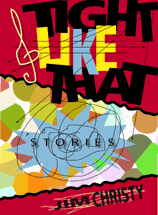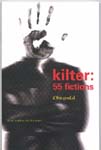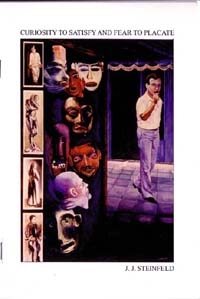Hey, Crumbling Balcony!
by Stuart Ross
ECW, 2003
Tight Like That
by Jim Christy
Anvil Press, 2003
Kilter: 55 fictions
by John Gould
Turnstone Press, 2003
Curiosity to Satisfy and Fear to Placate
by J.J. Steinfeld
Mercutio Press, 2003
Reviewed by Michael Bryson
Three works of fiction, one book of
poetry. What's the connection? There isn't one. They're all written by
men. They're all concerned with ... what the? what are we doing here?
 First, Hey, Crumbling Balcony! ...
a great title for a book, a terrific title for a
book by Stuart Ross. (See also Ross's website: hunkamooga.com.)
Here's a bit of the title poem (which is actually called "The True, Sad Tale of Benjamin Peret as it Relates to
Me"): First, Hey, Crumbling Balcony! ...
a great title for a book, a terrific title for a
book by Stuart Ross. (See also Ross's website: hunkamooga.com.)
Here's a bit of the title poem (which is actually called "The True, Sad Tale of Benjamin Peret as it Relates to
Me"):
Hey, balcony crumbling outside my window,
whose concrete organs plummet to the parking lot below,
know this: Benjamin Peret died in 1959
and in that year I was born.
He was photographed
in a toreador's get-up,
and thus was I born, hat and all
waving a cape at Dr. Bernie Ludwig,
I've the pictures to prove it.
If you haven't read anything by Stuart
Ross, Hey, Crumbling Balcony! is your one-stop shopping experience
to catch up on the work Ross has been contributing to Canlit in chapbook after chapbook,
and other work, since 1978. Subtitled "Poems New & Selected," Hey, Crumbling Balcony!
is one of the milestone tomes of 2003. It is also a profoundly
peculiar book ... or rather, a book full of the peculiar yet profound.
In thinking about what to write in this
review, those two words kept coming to the fore: peculiar, profound. The
sample quoted above provides enough of an example. Normally, one would
accuse writing that addresses an inanimate object (balcony) as if it
were a live, thinking, feeling thing (hey) of one of the basest of
flaws: "The balcony is not listening, Stuart." But Ross's
writing demands its own rules. In Ross's world, the balcony is listening
and thinking and more than likely feeling. Salvador Dali is not
Rembrandt, and Ross is not Dickens; he is closer to Kafka, Lewis Caroll, and Dr.
Suess.
Like the work of those writers, what is perhaps most striking about
Ross's work is the originality of its point of view. It is strange, yes.
But it is not scattergun weird. It is patterned; it is consistent; it is
art. Ross gives
us a re-imagined world, and the shape of that world becomes clearer as one
reads poem after poem. Ross's poetry is marked by a singular peculiar vision,
echoing with profundity, sustained over time.
His poems often mix concrete
detail (often images of marginalia, decay, weakness ... a crumbling
balcony) with flights of surrealism. But there is more than surrealism in
Ross's work. At least, there is more than weirdness. I am tempted to
say, "There is truth," but what is that? Perhaps this
quotation from George Saunders provides a clue. Saunders is the American
short story writer, whose own writing is a tad odd. In this quotation,
he is speaking of where his writing comes from:
What took me a really long time was realizing that just using my internal voice was all right, and it was the one I actually had to use. That internal voice was not anti-artistic, exactly, but it wasn't one I'd seen or heard before. I can remember thinking, You mean I should write that way, just like I think? It was really liberating for me to say, "I'm going to be a goofball for the rest of my life. I'm going to be a ninety-year-old guy with a fart cushion." It took a great weight off my shoulders.
http://www.theatlantic.com/unbound/interviews/ba2000-05-17.htm
That's truth. Feeling free to be
yourself. Putting on the page the voice you hear in your head, and not
trying to filter your voice to please anyone else: parents, teachers,
publishers, editors, readers.
Ross's voice resonates with integrity. The
voice is his poems echoes Kafka in that his narrators are often victims
of the world's absurdities. His poems echo the work of Dr. Suess in
their whimsy. At base, however, the poems belong to Ross alone.
They speak human truths, human realities. The repeated message is: It's a
strange world out there, a world with few solids, a world within which
the only thing stable is instability. There are references to the
real world -- Benjamin Peret, Ross's childhood friends, Randy Newman ...
attempts at connection that never seem to connect ... but there is also
deep feeling. Isn't this a deeper kind of realism? It is the way the
world is. Fragmentary. Always on the verge of collapse.
Some may find these poems freakish;
they are lovely.
 In Tight Like That, Jim
Christy's short story collection, the world is also lovely and freakish.
My mother read this book before I had a chance to read it. She liked it.
It isn't the sort of book I thought my mother would like. My mother
reads Ruth Rendell. Jim Christy is closer to Charles Bukowski than he is
to a British mystery writer. I think what my mother liked about these
stories was their lack of pretense. Tight Like That presents
fourteen stories about characters caught on the rough edges of society,
but his characters are not caught in bitterness, nor are they presented
as symbols of injustice and oppression. Christy tells worthy stories,
honest stories, well-written stories, too. In Tight Like That, Jim
Christy's short story collection, the world is also lovely and freakish.
My mother read this book before I had a chance to read it. She liked it.
It isn't the sort of book I thought my mother would like. My mother
reads Ruth Rendell. Jim Christy is closer to Charles Bukowski than he is
to a British mystery writer. I think what my mother liked about these
stories was their lack of pretense. Tight Like That presents
fourteen stories about characters caught on the rough edges of society,
but his characters are not caught in bitterness, nor are they presented
as symbols of injustice and oppression. Christy tells worthy stories,
honest stories, well-written stories, too.
Well-written in a plain style, it is
perhaps necessary to say, since Christy's writing is the type that
high-minded literary readers might distrust. The writing may appear
naive, it may appear unaware of it connotations, but it is not (in fact,
Christy often lulls the reader into expecting one outcome before revealing
another). Christy's storytelling is keen-minded, clever, and always one
step ahead of cliché. A bit like a British mystery writer, one is
tempted to say.
The back cover of Tight Like That
says:
The stories in Jim Christy's latest
collection span time and space, taking us from the depression-era Deep
South to the modern-day commute. Private eyes. Old drunks. Yuppies,
hippies, and everyone in between gets the trademark Christy work-over.
His characters inhabit a world where one wrong move, no matter how
small, can set in motion the direst of consequences. Luckily, they
don't let it get in the way of having a fine old time. Compelling,
transforming, this collection makes you long for the days when a cup
of coffee cost a dime, and dignity wasn't for sale.
I don't normally quote advertising copy
in reviews, but here I make an exception because the above paragraph is
an excellent summary of the book, though I have a couple of nits to
pick.
First, "the trademark Christy
work-over." Not having read any other Christy, I'm not sure what
this means. No one gets too much of a "work-over" in Tight
Like That. Hypocrites are poked and prodded, yes. Radical feminists,
the unthinking rich, politicians, narcissists generally. Christy's
narrators stand up for common sense, decency, and the protection of real
human connection. Christy's characters are often manly men, men who work
with their muscles, men more well-connected to their bodies than to
their minds, but his men are also in touch with their feelings, though
they aren't likely to abstract them; they aren't Momma's boys, or
friends of Freud.
Second, yes, dignity, truly, is not for
sale in Christy's world. But, overall, the tone is not nostalgic, as the back
cover blurb seems to suggest. Christy's stories are locked in the
present. They are fine, entertaining tales, written in language direct
and rife with integrity. The hint of nostalgia lingers perhaps
because Christy's storytelling may strike some as old-fashioned. Those
seeking hipster credentials can look elsewhere. Those hip to be square
can check out Tight Like That.
 John Gould's kilter: 55 fictions
was nominated for the 2003 Giller Prize. "Fifty-five
fictions?" you ask. Yes, there are 55 in this book's 205 pages, an
average of less than four pages per story. So, it didn't surprise this
reader that many of the stories feel like fragments, aborted beginnings,
chunks of middle. Which can be just fine, if the writing is strong. And
it is here, as the Giller nomination suggests. Gould's collected
fragments add up to a sum that is greater than its parts. John Gould's kilter: 55 fictions
was nominated for the 2003 Giller Prize. "Fifty-five
fictions?" you ask. Yes, there are 55 in this book's 205 pages, an
average of less than four pages per story. So, it didn't surprise this
reader that many of the stories feel like fragments, aborted beginnings,
chunks of middle. Which can be just fine, if the writing is strong. And
it is here, as the Giller nomination suggests. Gould's collected
fragments add up to a sum that is greater than its parts.
Here is the opening of the first story in the book:
I liked it better back when my son
was into stuff I could understand. Sex, drugs, rock'n'roll. Or rap, I
guess you'd call it, Yo, mufo, kind of thing, the white boy's
black dream. The big challenge in those days was to keep myself
upright on the couch late enough at night to catch him creeping in,
reeking of rum and Pepsi and Players Light, mauve hair all mussed up,
buttons in all the wrong button holes. What would his mother have
said? I'd ask myself.
"What would your mother have
said?" I'd ask him.
In contrast to Christy's manly men,
Gould's men are self-doubters. They are anxious. They are emotionally
complicated, in that never-ending contradictory sort of way that cliché
says is the singular realm of women (it isn't). If Christy tends towards
Bukowski, Gould tends towards the Richard Ford of The Sportswriter.
For example, let's look at the story
"Near-Death Experience." A mother is dying in hospital.
Her daughter, Boo, and the daughter's partner, Jack, sit by her bed. The
dying woman is asleep, semi-comatose, drifting towards death. The story
begins with Jack wanting to ask the dying woman about her experience. As
he explains to Boo: "How many chances like this does a person
get?"
Jack whispers, "She's been where
we're all going, Boo. Aren't you the tiniest bit curious about what
she's seen?"
"No. And anyway, I know what
she's seen. She's seen what she's always seen when she closes her
eyes. She sees the inside of her head."
Later, Jack asks Boo what she would
tell their child, if they had one, about "this" (death, the
afterlife, belief systems).
"I'd tell her . . . I have no
idea what I'd tell her," says Boo. "I'd tell her you can't
believe anything, you can't count on anything. I'd tell her the only
thing you can count on is the absolute, the infinite. Anything less
than that is a crock."
Jack says, "The absolute? The
infinite?"
"I have no idea. Mom, I miss
you, I do." Boo takes her mother's hand, kneads a knobby joint
between her fingertips.
"Near-Death Experience" covers barely four pages, and yet its
subject matter is as large as can be: death, love, the infinite. It is
also representative of Gould's other stories: the asking of big
questions, the ambiguous answers, the focus on the domestic. The
emphasis on small moments of truth: Boo will miss her mother, she offers
the simple solace of touch.
kilter: 55 fictions
was a worthy nomination for the 2003 Giller Prize. Some might find its
tone of post-modern skepticism relentless. Some might wish the stories
pushed outward, included more of the social context of its narrators,
instead of keeping its eye inward on relationships. Sure, whatever.
Gould's vision is his own, and in this book it is well realized.
 Curiosity to Satisfy and Fear to Placate,
a new chapbook of 11 stories in 23 pages from Mercutio
Press, by J.J. Steinfeld takes a philosophical approach to
big questions and ambiguous answers. One is challenged to articulate the
difference between Steinfeld and Gould. Gould may be more skeptical
than Christy, but Steinfeld is more skeptical than Gould. Gould still
finds some still points (see the "knobby joint"
above); Steinfeld, like Ross, articulates instability. Curiosity to Satisfy and Fear to Placate,
a new chapbook of 11 stories in 23 pages from Mercutio
Press, by J.J. Steinfeld takes a philosophical approach to
big questions and ambiguous answers. One is challenged to articulate the
difference between Steinfeld and Gould. Gould may be more skeptical
than Christy, but Steinfeld is more skeptical than Gould. Gould still
finds some still points (see the "knobby joint"
above); Steinfeld, like Ross, articulates instability.
In a recent interview with
TDR, Steinfeld speaks about his affinity for the writing of Samuel
Beckett and Franz Kafka:
While I have been drawn to the work of
Beckett and Kafka because they make me feel not alone, I cannot explain
why they tickle my fancy. Simply put, their writing makes sense to me.
Of all of Beckett’s extraordinary work, it is his play Waiting for
Godot that I have often revisited as a source of (disturbing)
comfort. In fact, the only play I’ve ever directed is a short one I
wrote, Godot’s Leafless Tree, about a character who is
convinced that today is the day that Godot finally arrives. I also have
a story version of this play, and it appears in Would
You Hide Me?
The stories in Curiosity to Satisfy and Fear to Placate
are drawn from the same inspiration. At least, they belong to the same
gen(i)us and species.
In the first story, the narrator
glances at a headline in the newspaper: DRINKER CHOKES TO DEATH ON WORD. Looking
more closely, the narrator finds the dead person choked on a
"worm." The story concludes: "You use your old fountain
pen to change a single headline letter, M to D, proofreader craving
redemption, and feel a little less uneasy about the dangerous semantics
in the world."
The second story is called, "You
Remember Sitting Across from God." This story is also written in
the second person. It begins: "While you are being interrogated ...
you are told in no uncertain terms that God is in the room silently
observing your behaviour." Yes, Kafka's The Trial is a
precursor. So are the Ten Commandments. This story ends: "Everyone
in the cold interrogation room, except you, claims to be God, but you
cannot see their eyes in the dark."
The third story seems to switch from
first-person to second-person between the first and second paragraphs.
It is called, "Exactitude is for Suckers." In it, the narrator
meets a "wild-eyed street preacher" on a street corner. The
preacher says, "Exactitude is for suckers and physicians nearing
retirement." The narrator replies, "The history of the world
should be written as to what we remember and what we forget, what we
kill and what we pass over, what we love, what we hate, yes, and what we
want and what gets thrown into our lives unwanted." The preacher
and a nearby busker go silent. They "flee down a side street slick
with rain and remorse, the emptiness now your captive audience, and
leaving you certain about uncertainty."
Certain about uncertainty. The
post-modern condition. When J.M. Coetzee recently won the Nobel Prize,
he went to Stockholm to give his acceptance speech and read
a short story instead. The press asked him, "Who was the man in
your story?" Coetzee answered, "I'm not sure." The
only thing stable is instability. Nobel Prize winners tell us this,
so do Canadian small press writers.
Curiosity to Satisfy and Fear to Placate
packs a big punch for such a small collection. It is not the usual
chapbook fare. It is literature daring to ask big questions ... and
admitting that the answers will still be a long time coming.
Michael Bryson is the
editor of The Danforth Review.
|